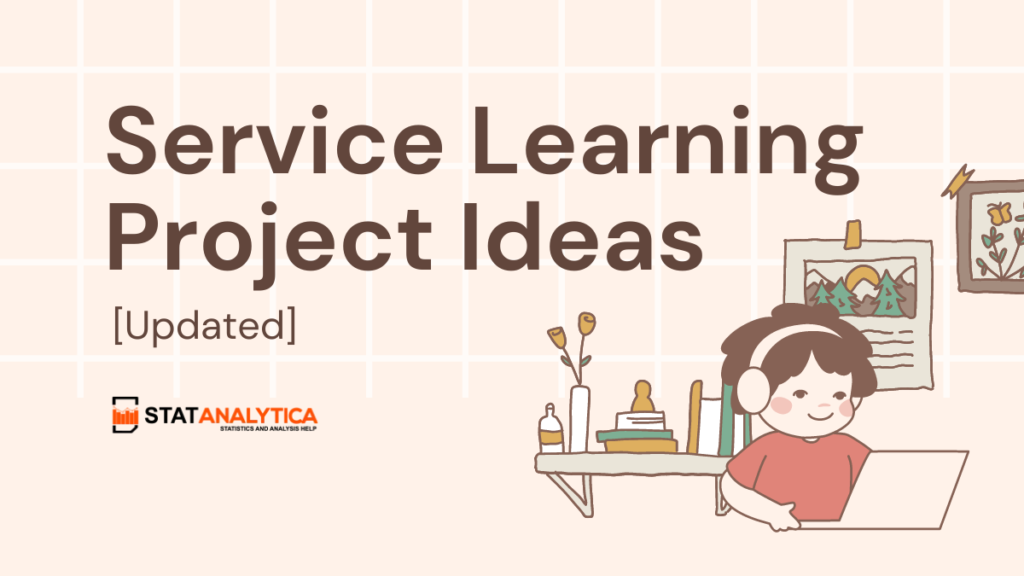In a world where empathy and action go hand in hand, service learning projects stand tall as avenues for making meaningful contributions to society. Service learning blends classroom education with community service, providing students with hands-on experiences that foster personal growth while addressing real-world challenges. If you’re eager to embark on a service learning journey but unsure where to start, fear not! In this guide, we’ll delve into a plethora of service learning project ideas suitable for various age groups and interests, empowering you to ignite positive change in your community.

What’s A Service Learning Project?
Table of Contents
A service learning project is an educational approach that integrates community service with academic learning. Students engage in hands-on activities that address real-world issues while gaining valuable skills and knowledge. These projects aim to foster personal growth, civic responsibility, and a deeper understanding of social issues.
What is an example of service learning?
An example of a service learning project could be a group of high school students volunteering at a local soup kitchen. In this project, students not only serve meals to those in need but also learn about issues such as food insecurity, poverty, and social inequality.
Through their hands-on experience, they develop empathy, teamwork skills, and a deeper understanding of societal challenges. Additionally, they may reflect on their experiences, discuss related academic concepts in class, and explore ways to address root causes of hunger and poverty in their community.
What Actions Would You Take To Perform A Service Learning Project?
To perform a service learning project, you would typically take the following actions:
- Identify a Community Need: Research and identify a specific issue or need within your community that you are passionate about addressing.
- Establish Learning Objectives: Define the educational goals and learning outcomes you hope to achieve through the project, ensuring alignment with academic curriculum standards or personal development objectives.
- Partner with Community Organizations: Reach out to local nonprofits, schools, government agencies, or community groups that are already working on related issues. Collaborate with them to understand the context, needs, and opportunities for involvement.
- Plan Project Activities: Develop a detailed plan outlining the activities, timelines, and resources required to execute the project effectively. Consider factors such as volunteer recruitment, logistics, budget, and safety protocols.
- Recruit Volunteers: Engage classmates, teachers, parents, and other community members to participate in the project. Provide clear information about roles, responsibilities, and expectations to ensure effective collaboration.
- Implement Service Activities: Carry out the planned service activities, whether it involves direct service (e.g., volunteering at a shelter), indirect service (e.g., organizing a fundraising event), or advocacy efforts (e.g., raising awareness about a social issue).
- Reflect on Experiences: Facilitate reflection sessions to encourage participants to think critically about their experiences, emotions, and insights gained from the project. Discuss the connections between service and academic learning, as well as the broader implications for personal growth and social change.
- Evaluate Impact: Assess the impact of the service learning project by gathering feedback from participants, community members, and stakeholders. Evaluate outcomes in terms of both academic learning and community benefit, and identify lessons learned for future projects.
- Celebrate Achievements: Recognize and celebrate the achievements of participants, volunteers, and community partners. Showcase the positive impact of the project through presentations, reports, media coverage, or public events.
- Sustain Engagement: Explore opportunities to sustain engagement with the issue beyond the initial project period. Encourage ongoing involvement through continued volunteering, advocacy efforts, or partnerships with other organizations.
By following these steps, you can effectively plan, implement, and evaluate a service learning project that makes a meaningful difference in your community while promoting learning and personal growth.
50 Service Learning Project Ideas: Category Wise
Environmental Conservation and Sustainability
- Organize a beach or river clean-up event.
- Establish a community garden to promote sustainable agriculture.
- Conduct energy audits and implement conservation measures in local schools or businesses.
- Create a recycling program for a neighborhood or community center.
- Plant trees in urban areas to improve air quality and promote biodiversity.
Education and Literacy
- Tutor elementary school students in math, reading, or other subjects.
- Start a book drive to collect books for underprivileged children or schools.
- Volunteer at a local library to assist with literacy programs or book sorting.
- Create educational materials or lesson plans on environmental conservation for local schools.
- Organize a storytelling or reading event for children at a daycare center or hospital.
Health and Wellness
- Organize a community health fair offering free screenings and information on healthy living.
- Visit a nursing home or assisted living facility to spend time with older people who live there.
- Lead fitness classes or sports activities for children with disabilities.
- Plan and implement a mental health awareness campaign in schools or the community.
- Create a neighborhood garden where we grow healthy fruits and veggies specifically for people who don’t have enough food to eat.
Social Justice and Advocacy
- Advocate for affordable housing by organizing community forums and petitions.
- Volunteer at a local food bank or soup kitchen to help alleviate hunger.
- Raise awareness about immigration issues through educational workshops and events.
- Mentor at-risk youth to provide guidance and support in navigating challenges.
- Organize a clothing drive for homeless shelters or refugee resettlement organizations.
Technology and Digital Literacy
- Teach senior citizens how to use computers, smartphones, and the internet.
- Create a website or social media campaign to raise awareness about a social or environmental issue.
- Volunteer at a community center to provide tech support and training to residents.
- Develop educational apps or games to teach coding or STEM concepts to children.
- Host a virtual coding workshop for students interested in learning programming skills.
Animal Welfare
- Help out at an animal shelter by taking care of and spending time with pets waiting to find new homes.
- Organize a pet supply drive to collect food, toys, and other essentials for shelter animals.
- Teach people in the community how to take good care of their pets and explain why it’s important to have them spayed or neutered.
- Assist with wildlife conservation efforts by participating in habitat restoration projects.
- Advocate for animal rights by organizing protests or letter-writing campaigns targeting policymakers.
Community Development
- Partner with a local Habitat for Humanity chapter to build or repair homes for low-income families.
- Organize a community clean-up day to beautify public spaces and parks.
- Plan and execute a neighborhood revitalization project focused on improving infrastructure and amenities.
- Create a community resource directory listing available services such as food banks, healthcare clinics, and job training programs.
- Establish a community tool library where residents can borrow tools and equipment for DIY projects.
Cultural Exchange and Diversity
- Host a cultural festival or potluck dinner to celebrate diversity and promote cross-cultural understanding.
- Organize a language exchange program pairing native speakers with learners of a different language.
- Volunteer at a refugee resettlement agency to assist newcomers with language skills, job training, and cultural orientation.
- Create a mural or public art installation representing the diverse cultures and heritage of the community.
- Organize a community storytelling project where residents share personal narratives and experiences.
Emergency Preparedness and Disaster Relief
- Develop emergency preparedness kits and distribute them to vulnerable populations such as seniors or low-income families.
- Train community members in CPR, first aid, and disaster response skills.
- Assist with disaster relief efforts by volunteering at shelters or distributing supplies to affected areas.
- Create informational materials and workshops on disaster preparedness and resilience.
- Organize a fundraising campaign to support disaster relief organizations and recovery efforts.
Sustainable Transportation
- Advocate for bike lanes, sidewalks, and other pedestrian-friendly infrastructure improvements in the community.
- Organize a bike repair workshop to teach basic maintenance skills and promote cycling as a sustainable mode of transportation.
- Coordinate a carpooling or ridesharing program to reduce traffic congestion and carbon emissions.
- Host a public forum on public transportation accessibility and affordability.
- Implement a “Walk to School” initiative to encourage students and families to prioritize walking as a healthy and eco-friendly transportation option.
How Is Service Learning Different From Volunteering?
Service learning and volunteering are both forms of community service, but they differ in their approach, purpose, and integration with education:
- Integration with Education:
- Service Learning: Service learning integrates community service with academic learning. Students engage in service activities that are directly related to course content or learning objectives. Reflection and critical analysis of the service experience are often incorporated into the educational process.
- Volunteering: Volunteering typically involves individuals freely giving their time and skills to support a cause or organization without a direct academic component. While volunteering may provide valuable experiences and personal growth opportunities, it is not necessarily linked to formal education or structured learning outcomes.
- Academic Emphasis:
- Service Learning: In service learning, the primary emphasis is on learning and personal development. Service activities are chosen or designed to enhance academic learning, develop critical thinking skills, and promote civic engagement.
- Volunteering: While volunteering may also contribute to personal growth and skill development, its primary focus is on providing assistance or support to a cause or organization. The emphasis is on the service provided rather than the educational or developmental outcomes for the volunteer.
- Reciprocity and Mutuality:
- Service Learning: Service learning emphasizes reciprocity and mutuality, meaning that both the community and the students benefit from the service experience. Students contribute to addressing community needs while also gaining knowledge, skills, and insights from their service experiences.
- Volunteering: Volunteering may involve a similar sense of giving back to the community, but there may be less emphasis on reciprocal benefits or intentional learning outcomes for the volunteer.
- Reflection and Integration:
- Service Learning: Reflection is a central component of service learning. Students are encouraged to reflect on their service experiences, connect them to course content or academic learning objectives, and consider the broader social, ethical, and civic implications of their actions.
- Volunteering: While volunteers may reflect on their experiences and personal growth, reflection is not always a formal or structured component of volunteering activities. Volunteers may choose to reflect individually or discuss their experiences with peers, but it is not necessarily integrated into a broader educational framework.
In summary, while both service learning and volunteering involve community service, service learning is distinct in its intentional integration with academic learning, emphasis on reciprocal benefits, and structured reflection process.
Service learning provides students with opportunities to apply classroom knowledge to real-world contexts, develop critical thinking skills
Conclusion
Service learning project ideas offer a unique opportunity for students and educators alike to make a tangible difference in their communities while simultaneously enhancing their academic learning and personal development.
Whether you’re passionate about environmental conservation, education, health, social justice, or any other cause, there’s a service learning project out there waiting for you to bring it to life.
So, roll up your sleeves, rally your peers, and embark on a journey of service, learning, and meaningful change. Together, we can build a brighter future for all.


